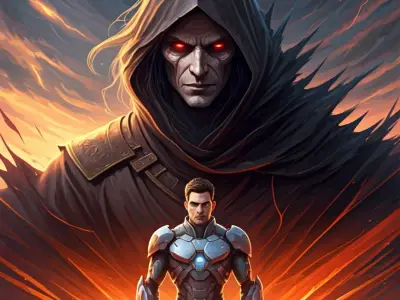Have you ever watched a film or read a book and felt that one character stood out almost as much as the hero? Perhaps this character was at the hero’s side for much of the story, shaping the plot and adding richness to the journey. This person is called the deuteragonist.
Whether you’re a reader, a writer, or just someone who loves understanding stories better, this blog explores the role deuteragonists play in storytelling, why they matter, and how you can spot them.
Jump to:
- What is a Deuteragonist?
- Why Are Deuteragonists Important For Character Development?
- Deuteragonist vs Protagonist vs Antagonist
- Deuteragonist Examples in Literature, Film, and TV
- The Deuteragonist’s Importance in Storytelling
- Tips for Writing a Strong Deuteragonist
- Frequently Asked Questions About Deuteragonists
- Study Our Novel Writing Diploma for £29
Recommended for you!
Best SellersWhat is a Deuteragonist?
The deuteragonist is the second most important person in a story. The term comes from ancient Greek theatre, where the “deuteragonist” was introduced after the “protagonist” (the main character), and often acted as their companion, rival, or complement.
A deuteragonist can be a loyal best friend, a challenging rival, a strong love interest, or sometimes a character whose arc mirrors or contradicts that of the protagonist.
Why Are Deuteragonists Important For Character Development?

Deuteragonists often highlight different sides of the protagonist, allowing readers or viewers to understand their motivations and struggles more clearly. They can also drive character growth by challenging, supporting, or contrasting the main character. By acting as a mirror or a counterbalance, a deuteragonist can reveal strengths, flaws, and vulnerabilities that might otherwise stay hidden. This dynamic makes the story richer and more layered, allowing readers to connect more deeply with both characters and their journey.
Deuteragonist vs Protagonist vs Antagonist
To make sense of where the deuteragonist fits in:
- The Protagonist is the central character — the person you follow from start to finish.
- The Deuteragonist is the second lead — an important character closely tied to the protagonist.
- The Antagonist is typically the person (or force) that opposes the protagonist.
For example, in The Lord of the Rings, Frodo is the protagonist, Samwise is the deuteragonist, and Sauron is the antagonist.
Deuteragonist Examples in Literature, Film, and TV
To help you understand the role better, here are some well-known deuteragonist examples:
Jack Sparrow - Pirates of the Caribbean
Although Jack Sparrow is often thought of as the main character, Will Turner is the central focus of the story. This makes Jack Sparrow the deuteragonist.
Hermione Granger - Harry Potter
In the Harry Potter series, Harry is the protagonist, while Hermione Granger serves as the deuteragonist. She supports Harry and plays a key role in many pivotal moments throughout the story.
Jack - Titanic
In the film Titanic, Rose is the main character, and Jack serves as the deuteragonist. He provides depth, motivation, and emotional weight to Rose’s character arc.
Elsa - Frozen
In Frozen, Anna is the protagonist, while Elsa acts as the deuteragonist for much of the story.
Peeta Mellark - The Hunger Games
In The Hunger Games, Katniss is the protagonist, and Peeta serves as the deuteragonist. His character develops alongside hers, and their dynamic drives much of the story.
Han Solo - Star Wars
In the original Star Wars films, Luke is the protagonist, while Han Solo serves as the deuteragonist. His charm, loyalty, and character arc deepen the story and balance Luke’s heroism.
The Deuteragonist’s Importance in Storytelling
Why do writers use deuteragonists? Here are a few reasons:
- Depth: A deuteragonist can mirror or oppose the protagonist, adding richness and emotional complexity.
- Varied Perspectives: They give readers or viewers a second lens through which to understand the story.
- Character Growth: By challenging or supporting the protagonist, the deuteragonist encourages character development.
- Balance: They can balance out a story, making it more dynamic and relatable.
If you’ve ever wondered why a character is so memorable, it’s because deuteragonists help create moments of connection and tension that linger long after the story ends.
Tips for Writing a Strong Deuteragonist

Creating a strong deuteragonist can make your story more compelling, memorable, and rewarding for readers. Here are a few tips to help you develop a character who shines alongside your protagonist:
1. Give Them a Clear Role
Decide why your deuteragonist is in the story. Will they support, challenge, or complicate the protagonist’s journey? Understanding their purpose will help you write a character that feels vital to the plot.
2. Make Them Relatable
Even if your deuteragonist is very different from the main character, readers should be able to connect with their feelings, struggles, or motivations. This gives them depth and makes readers care about their role.
3. Develop Their Own Goals
While a deuteragonist often supports the protagonist, they should also have their own aims, dreams, and challenges. This makes the character more three-dimensional and prevents them from feeling like a mere sidekick.
4. Show Their Growth
A strong deuteragonist evolves throughout the story. Perhaps their relationship with the protagonist changes, or their understanding of themselves deepens. Let their arc unfold naturally to give the character resonance and emotional impact.
5. Create a Strong Dynamic
The best deuteragonists have a compelling relationship with the protagonist, one that sparks conflict, collaboration, or mutual growth. This dynamic can drive moments of tension, emotion, and reflection in the story.
6. Give Them Their Own Moment to Shine
Allow the deuteragonist moments of heroism or vulnerability. This not only develops their character but also gives readers reasons to root for them and remember their role long after the story ends.
Frequently Asked Questions About Deuteragonists
What is the difference between a deuteragonist and a tritagonist?
The deuteragonist is the second most important character in a story, while the tritagonist is the third. The tritagonist often provides additional support or conflict but plays a smaller role than the protagonist and deuteragonist.
Are deuteragonists always friends with the protagonist?
A deuteragonist can be a friend, rival, or even an enemy of the protagonist. What defines them is their significance to the story and their relationship with the main character.
Can a story have more than one deuteragonist?
Some stories feature more than one character who can be considered a deuteragonist, especially in ensemble casts where multiple characters have significant arcs and connections to the protagonist.
Are deuteragonists always present throughout the story?
Deuteragonists usually have a strong presence across much of the storyline, but this doesn’t mean they must appear in every scene. What matters is their overall impact and role within the narrative.
Is the deuteragonist always a person?
In some stories, a deuteragonist can be an animal, a supernatural being, or even a symbolic force, anything that significantly influences the protagonist’s journey.
Can the deuteragonist become the protagonist in a sequel or spin-off?
In many cases, a deuteragonist becomes the focus of later stories. This allows writers to expand their world and deepen the character’s role.
Recommended for you!
Best SellersStudy Our Novel Writing Diploma for £29
Now that you’ve explored the role of the deuteragonist in storytelling, you might feel inspired to apply this character to your own stories. The Novel Writing Diploma Course at the Centre of Excellence is the perfect next step. The course is designed for writers of all levels and covers every stage of writing a novel, from initial idea to final polish. For a limited time, you can enrol for a discounted price of £29!













